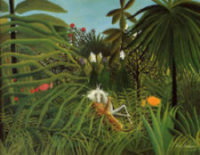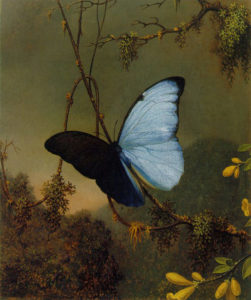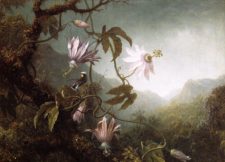Henri Rousseau was a tax collector and self-taught painter who never left Paris and never saw a jungle, taking inspiration instead from Paris’ hothouse botanical gardens.  “When I go into the glass houses and I see the strange plants of exotic lands,” he was quoted as saying, “it seems to me that I enter into a dream.”
“When I go into the glass houses and I see the strange plants of exotic lands,” he was quoted as saying, “it seems to me that I enter into a dream.”
What is it about jungles that evokes a dream-world? Is the teeming life, the sensual, sexual—steamy, fecund, wet—lushness, the undercurrent of threat and violence, the wild remove from our tamed daily lives?
Another late nineteenth century painter, Martin Johnson Heade, an American landscape and still life painter, traveled to Central and South America to paint small, carefully-observed, atmospheric works of tropical birds and foliage. While Rousseau was painting in Paris’ Jardin des Plantes, Heade was at work in the jungles of Brazil, Nicaragua, and Jamaica. All the same, Heade’s paintings seem almost as dreamlike and unreal as Rousseau’s.
to Central and South America to paint small, carefully-observed, atmospheric works of tropical birds and foliage. While Rousseau was painting in Paris’ Jardin des Plantes, Heade was at work in the jungles of Brazil, Nicaragua, and Jamaica. All the same, Heade’s paintings seem almost as dreamlike and unreal as Rousseau’s.
One painter recorded his imaginings of a world, inspired by the plants he saw; the other painted the real environment he was seeing, filtered through his own imagination. Though both worked a hundred years ago, their visions feel timeless, matching well with our own sense of an exotic, tropical wilderness. The imaginative source of the jungle of our dreams, with its evocation of the primitive—at once seductive and ominous—has the power to override even an actual experience of the jungle itself.

Leave a Reply